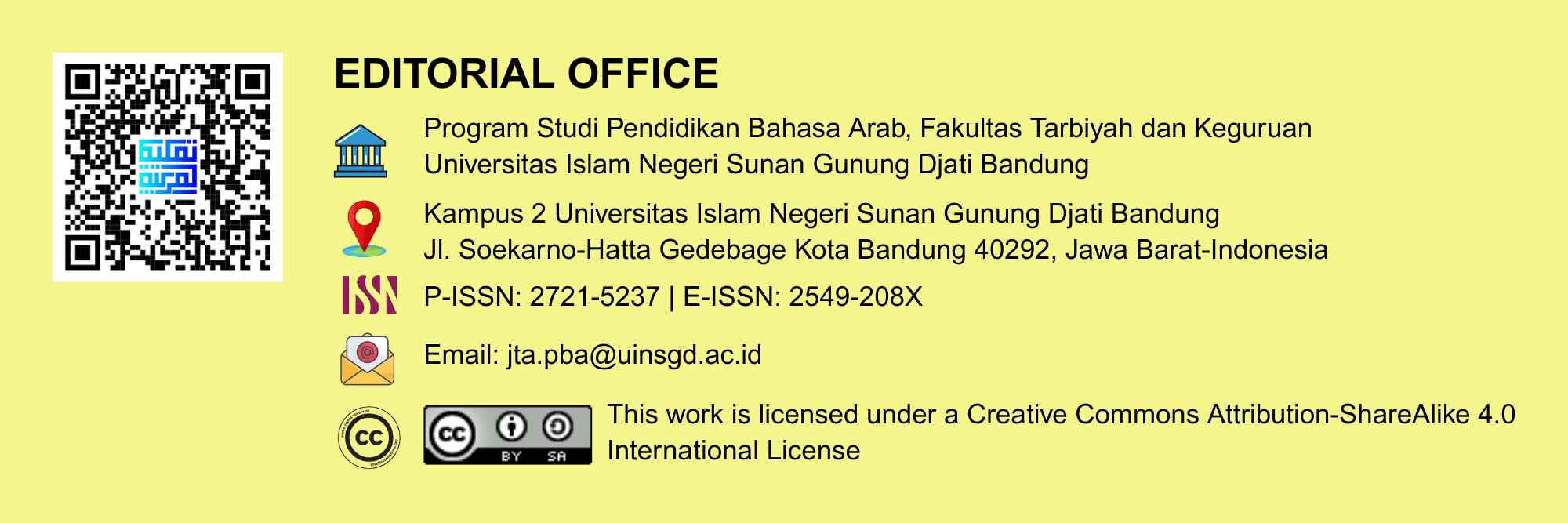Typology of Student Learning in Qira’ah Subject with Multiple Intelligence Perspective
DOI:
https://doi.org/10.15575/jpba.v5i1.12434Abstract
This study tries to reveal the typology of student learning in Qira'ah subjects, the Multiple Intelligence of students in these subjects, and the relationship between student learning typology in Qira'ah subjects from the perspective of Multiple Intelligences. The Subjects in this study were students of the Jam'iyah Ihsaniyah al-Mukhtariyah Kerinci Islamic Boarding School. This research uses qualitative and quantitative methods. The results showed that the type of student learning in Qira'ah subjects consisted of Auditory learning types, followed by Visual learning types and some students had Kinesthetic learning styles. The intelligence possessed by students when taking Qira'ah lessons is Linguistic or Verbal intelligence which functions to utilize language to communicate. Visual Intelligence is useful for analyzing facts and realities that are seen directly and Kinesthetic Intelligence to directly capture the material. In the Qira'ah subject at the Jam'iyah Ihsaniah al-Mukhtariyah Kerinci Islamic Boarding School, students' learning styles are closely related to multiple intelligences to develop directed and effective learning abilities and processes.
References
Ardiansyah, Ade Arip and Azhar Muhammad. 2020. “Implementation of Integrative Arabic Grammar (Nahwu & Sharaf) Curriculum in Islamic Boarding School.†Izdihar : Journal of Arabic Language Teaching, Linguistics, and Literature 3(3):211–28.
Asadi, Ibrahim A., Asaid Khateb, and Michal Shany. 2017. “How Simple Is Reading in Arabic? A Cross-Sectional Investigation of Reading Comprehension from First to Sixth Grade.†Journal of Research in Reading 40:S1–22.
Asrori, Imam, Muhammad Thohir, and Moh Ainin. 2012. “Evaluasi Pembelajaran Bahasa Arab.†Malang: Misykat.
Bire, Arylien Ludji, Uda Geradus, and Josua Bire. 2014. “Pengaruh Gaya Belajar Visual, Auditorial, Dan Kinestetik Terhadap Prestasi Belajar Siswa.†Jurnal Kependidikan: Penelitian Inovasi Pembelajaran 44(2).
Dolati, Zahra and Abdorreza Tahriri. 2017. “EFL Teachers’ Multiple Intelligences and Their Classroom Practice.†SAGE Open 7(3):1–12.
Ediyani, Muhammad, Kasful Anwar, Husaini Husaini, Ridha Zuhaimi, and Taufiq Hidayat. 2020. “The Analysis of Arabic Learning Materials in Al-‘Arabiyah Baina Yadaik Book with the Principle of Material Development Approach.†Budapest International Research and Critics Institute (BIRCI-Journal): Humanities and Social Sciences 3(2):965–74.
Efendi, Ahmad Fuad. 2005. “Metodologi Pengajaran Bahasa Arab.†Malang: Misykat.
Fauzia, Mutia, Ade Nandang Slamet, and Heri Gunawan. 2019. “PENGGUNAAN TEKNIK PERMAINAN BERBURU TARKIB TERHADAP KEMAMPUAN SISWA DALAM PEMBELAJARAN BAHASA ARAB MATERI TARKIB.†Ta’lim Al-’Arabiyyah: Jurnal Pendidikan Bahasa Arab & Kebahasaaraban 3(1):1–13.
Gilakjani, Abbas Pourhossein. 2012. “Visual, Auditory, Kinaesthetic Learning Styles and Their Impacts on English Language Teaching.†Journal of Studies in Education 2(1):104–13.
Hamzah, Amir. 2009. “Teori Multiple Intelligences Dan Implikasinya Terhadap Pengelolaan Pembelajaran.†TADRIS: Jurnal Pendidikan Islam 4(2).
Kayalar, Fethi and Filiz Kayalar. 2017. “The Effects of Auditory Learning Strategy on Learning Skills of Language Learners (Students’ Views).â€
Makhoul, Baha. 2017. “Moving beyond Phonological Awareness: The Role of Phonological Awareness Skills in Arabic Reading Development.†Journal of Psycholinguistic Research 46(2):469–80.
Muid, Abdul, Sulhi Muhamad Daud Abdul Kadir, Noza Aflisia, and Neldi Harianto. 2020. “Learning Model of Speaking Arabic: Field Research Based on Constructivism Theory at Al Muhsinin Islamic Boarding School Kerinci.†Alsuna: Journal of Arabic and English Language 3(2):140–51.
Mustofa, Syaiful. 2011. Strategi Pembelajaran Bahasa Arab Inovatif. UIN-Maliki Press.
Owens, Jonathan. 1990. Early Arabic Grammatical Theory: Heterogeneity and Standardization. Vol. 53. John Benjamins Publishing.
Rahman, Anwar Abd. 2018. “Keterampilan Membaca Dan Teknik Pengembangannya Dalam Pembelajaran Bahasa Arab.†Diwan : Jurnal Bahasa Dan Sastra Arab 3(2):155.
Rahman, Rifqi Aulia. 2018. “KEMAHIRAN QIRĀ’AH DAN KONSIDERASI STRATEGI PEMBELAJARAN.†Lisanan Arabiya: Jurnal Pendidikan Bahasa Arab 2(1):97–120.
Rile, Luis G., Maria Jade Catalan- Opulencia, Nino M. Decenorio, and Nemia L. Tan. 2015. “Multiple Intelligences of Students with Learning Disabilities: Its Implication for Business Curriculum Development in United Arab Emirates.†Procedia Economics and Finance 23(October 2014):894–98.
Rohaniyah, Jaftiyatur. 2017. “Integrating Learning Style and Multiple.†Jurnal Pemikiran Penelitian Pendidikan Dan Sains 5(1):19–27.
Widayanti, Febi Dwi. 2013. “Pentingnya Mengetahui Gaya Belajar Siswa Dalam Kegiatan Pembelajaran Di Kelas.†Erudio Journal of Educational Innovation 2(1).
Widayanti, Rizka and Yelfi Dewi. 2020. “Implementation of Arabic Learningbased on Multiple Intelligences at Al-Kautsar Elementary School Malang.†AL-FURQAN 5(2):22–35.
Winarti, Atiek, Leny Yuanita, and Moh Nur. 2019. “The Effectiveness of Multiple Intelligences Based Intelligences and Science Process Skills of Junior High School Students.†Journal of Technology and Science Education 9(2):122–35.
Yavich, Roman and Irina Rotnitsky. 2020. “Multiple Intelligences and Success in School Studies.†International Journal of Higher Education 9(6):107–17.
Downloads
Published
How to Cite
Issue
Section
Citation Check
License
Authors who publish in Ta'lim al-'Arabiyyah: Jurnal Pendidikan Bahasa Arab dan Kebahasaaraban agree to the following terms:
- Authors retain copyright and grant the journal right of first publication with the work simultaneously licensed under a Creative Commons Attribution-ShareAlike 4.0 International (CC BY-SA 4.0) License that allows others to share the work with an acknowledgment of the work's authorship and initial publication in this journal.
- Authors are able to enter into separate, additional contractual arrangements for the non-exclusive distribution of the journal's published version of the work (e.g., post it to an institutional repository or publish it in a book), with an acknowledgment of its initial publication in this journal.
- Authors are permitted and encouraged to post their work online (e.g., in institutional repositories or on their website) prior to and during the submission process, as it can lead to productive exchanges, as well as earlier and greater citation of published work (See The Effect of Open Access).
![]()
Ta'lim al-'Arabiyyah: Jurnal Pendidikan Bahasa Arab dan Kebahasaaraban is licensed under a Creative Commons Attribution-ShareAlike 4.0 International License.
Based on a work at https://journal.uinsgd.ac.id/index.php/Talim








